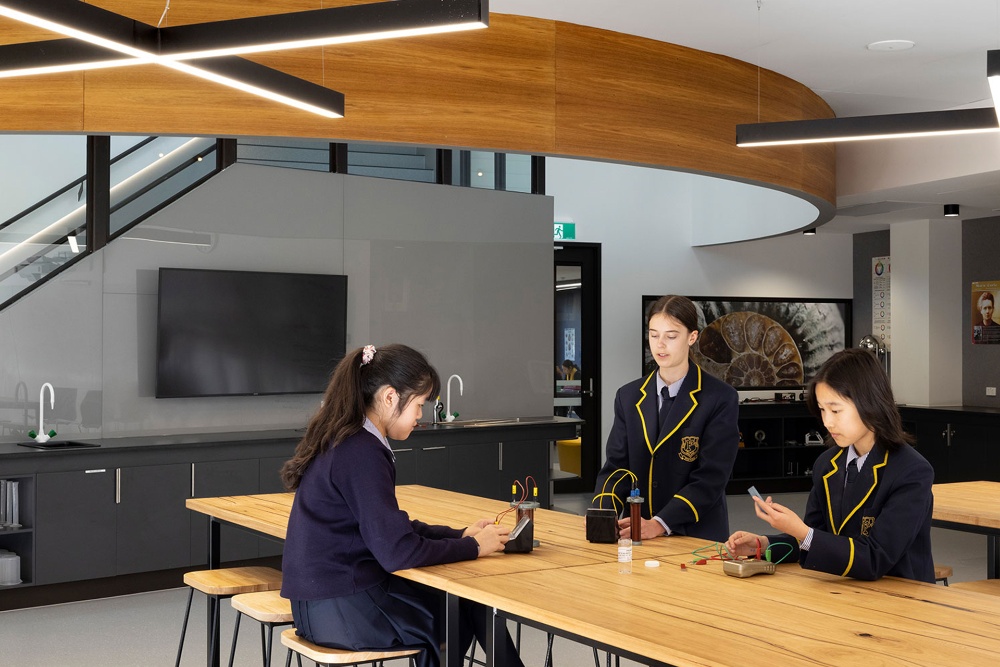Collaboration is at the heart of STEM education. Whether students are building prototypes, coding software or brainstorming solutions to real-world problems, collaborative STEM learning spaces encourage teamwork, creativity and innovation.
Creating such spaces requires careful planning, combining flexible furniture, technology integration and ergonomic design to foster interaction and engagement. Here’s how you can design collaborative STEM environments that empower students to succeed.
The Importance of Collaboration in STEM
STEM disciplines mirror real-world workplaces, where teamwork and communication are essential. Collaborative STEM learning spaces help students:
- Develop problem-solving skills through group projects.
- Share ideas and learn from diverse perspectives.
- Build communication and leadership skills that prepare them for future careers.
When classrooms are designed for collaboration, students thrive in environments that mimic professional settings.
Key Features of Collaborative STEM Learning Spaces
-
Open Layouts for Flexibility
Collaborative spaces require open layouts that can adapt to different activities. Flexible classroom furniture, such as modular tables and movable chairs, allows educators to quickly rearrange the room for group discussions, hands-on activities or presentations. -
Technology Integration
Collaborative STEM spaces should support technology with features like shared screens, charging ports and cable management systems. For example, adjustable workstations with built-in tech capabilities can accommodate both group and individual tasks seamlessly. -
Ergonomics and Comfort
Comfort is key for long-term focus and engagement. The role of ergonomics in STEM classroom furniture cannot be understated, as it ensures students can comfortably work on projects, whether seated or standing. -
Storage for STEM Equipment
Efficient storage solutions for STEM classrooms help keep tools, materials and equipment organised and accessible. Mobile storage units allow teams to quickly grab what they need, reducing setup time and boosting productivity.
How VE Furniture Supports Collaborative STEM Learning
At VE Furniture, we design and supply furniture solutions that meet the unique demands of collaborative STEM environments. Our products are built for flexibility, durability and comfort, ensuring that every student has the tools they need to succeed.
By combining these products, educators can create a space that adapts to the needs of their students while fostering collaboration.
Integrating Subtopic Concepts into Collaborative Spaces
While designing collaborative spaces, it’s essential to consider other key elements of STEM classrooms:
- Flexible Furniture: Incorporate movable tables and ergonomic seating to create versatile spaces that adapt to different tasks. Learn more in our guide on Flexible Classroom Furniture for STEM Education.
- Ergonomics: Ensure your furniture supports proper posture and comfort for students. Discover tips in The Role of Ergonomics in STEM Classroom Furniture.
- Storage Solutions: Keep tools and materials organized with mobile storage units and lockable cabinets. Explore ideas in Storage Solutions for STEM Classrooms.
Steps to Design Collaborative STEM Learning Spaces
- Assess Your Needs: Evaluate the activities your students will engage in, from group projects to hands-on experiments.
- Choose Flexible Furniture: Opt for modular desks and mobile seating to accommodate different setups.
- Incorporate Technology: Ensure your space has adequate outlets, charging stations and shared screens.
- Plan for Storage: Use mobile caddies and shelving units to organize equipment and minimise clutter.
- Focus on Ergonomics: Select seating and workstations that promote comfort and focus.
The Future of Collaborative STEM Education
Collaborative STEM learning spaces represent the future of education, fostering creativity, innovation and teamwork. By designing classrooms that support interaction and adaptability, educators can prepare students for success in a rapidly evolving world.
VE Furniture is here to help you create a STEM classroom that inspires collaboration and innovation. Our range of flexible, ergonomic and durable furniture solutions is tailored to meet the needs of today’s educators and students.


/Buzz%20Chair/BUZ004-SFX.jpg)


/Shinto/SHI043%20-%20Shinto%20Creator/SHI043-BLK-S-NTO-PWR-1.png?width=950&height=950&name=SHI043-BLK-S-NTO-PWR-1.png)
/Techno/TEC002%20-%20Techno%201200/TEC002-750x750-HERO.png?width=750&height=750&name=TEC002-750x750-HERO.png)
/Tower/TOW002-W-NTO-2-1.png?width=900&height=900&name=TOW002-W-NTO-2-1.png)
/Flex/Flex-stool.png?width=600&height=600&name=Flex-stool.png)
/Island/ISL007%20-%20Island%20Curve%20Tectonic/ISL007-L-NTO-TOM-HERO-750x750.png?width=750&height=750&name=ISL007-L-NTO-TOM-HERO-750x750.png)
/Fusion/Fusion%20Storage%20Unit%20Oak.png?width=600&height=600&name=Fusion%20Storage%20Unit%20Oak.png)